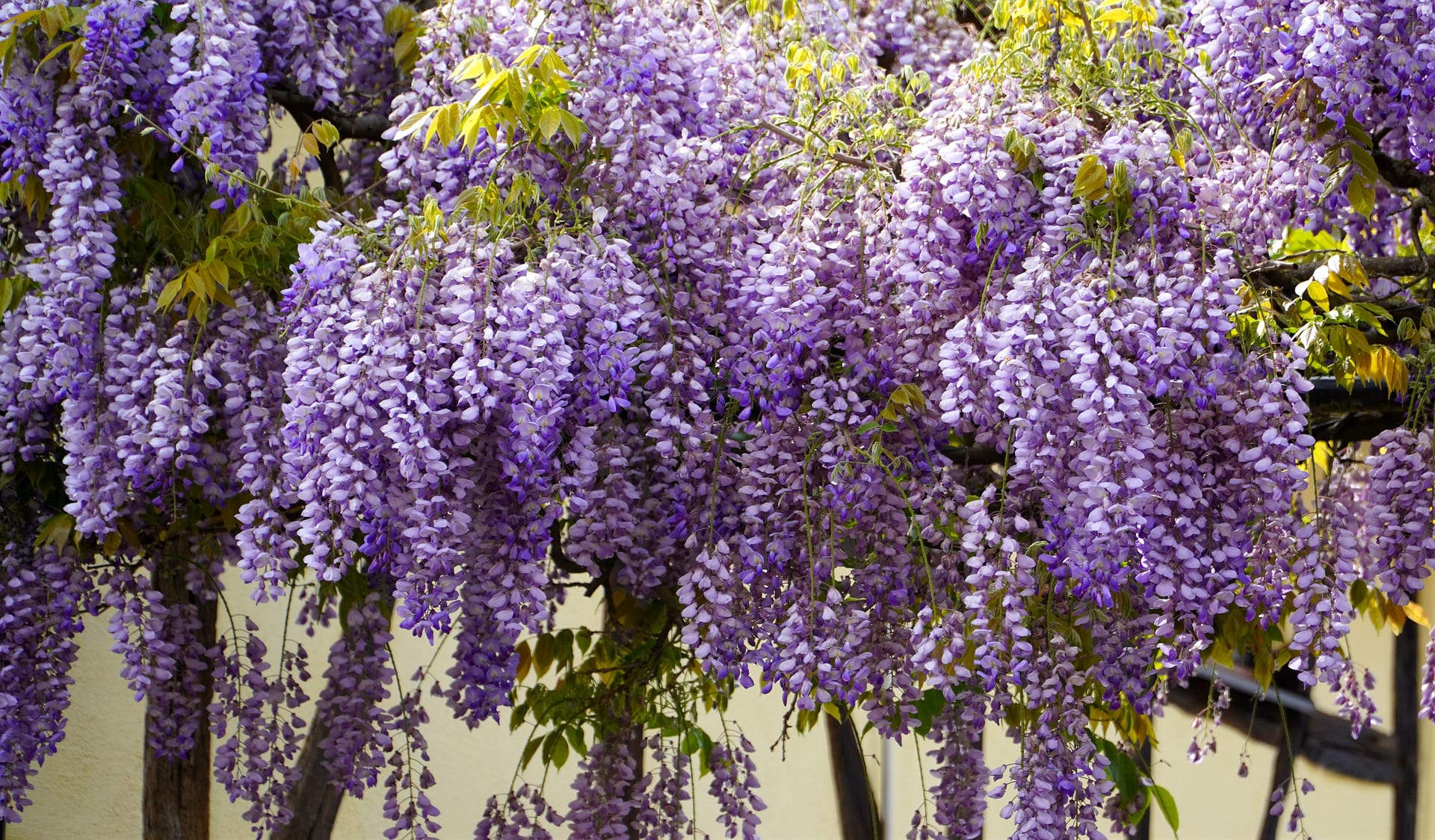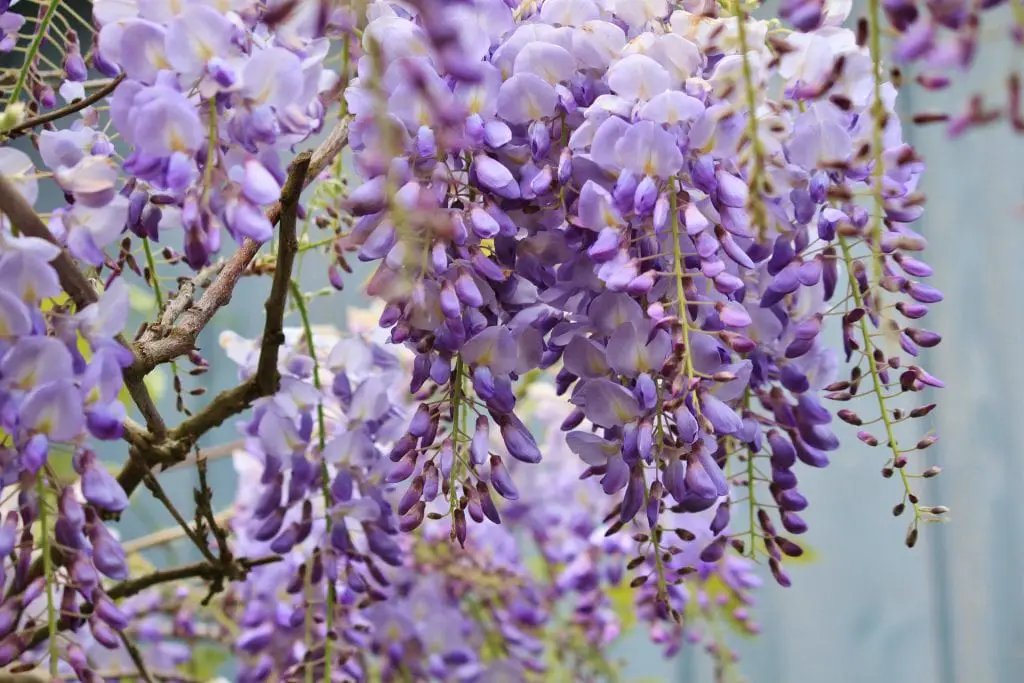
Wisteria is a plant that is a vine. Climbing to great heights, its blooming time occurs in spring. Wisteria is a flowering plant, yielding huge, drooping lilac flowers in clusters. The clusters are dense violet or purple flowers with blue tints. Flowers are wonderfully fragrant, stimulating your senses, both visually and through smell. After the plant has bloomed fully, brown pods that look like beans remain on the vine till winter starts. Flowers reappear on new growth, in the next blooming season. You’ll find that growing wisteria is a rewarding experience.
Being a vine, wisteria lives for a long span of time. Virtually cascading bluish lilac flowers look like resplendent drapes. These could hang from an arch or a pergola in your garden. The best times for these spectacular flowers to bloom are spring and summer. Wisteria is a swift grower and an aggressive one at that. Really long plants are more than 30 feet in length. Since the vine is so dense, it is also heavy and bears down on whatever is supporting it. Being invasive, Wisteria vines find their way into any crack and hole. The plant will be drawn into tiny crevices, so it is advisable not to plant it too close to the structure of your house.
A word of caution
Before you plant and consider growing wisteria, you need to give the idea a long, hard think if you have pets and/or children. The entire plant contains wisterin and lectin. These two substances are toxic to pets, livestock, and human beings. If they are consumed at all, they can cause noxious reactions like nausea and severe diarrhea.
Plant invasion
There are particular species of wisteria that are not native to North America. These species are Japanese wisteria and Chinese wisteria. Growing wisteria of these two species is thought of as growing invasive plants. The native species of the plant, called American wisteria and Kentucky wisteria are the non-invasive types. Compared to the Asian ones, these are good bets to go with when you’re planting new flora.
The difference
To know which species to plant, you obviously need to be able to tell the difference between the Asian and American species of plants. As regards seed pods, Asian varieties have pods that are fuzzy. American wisteria’s seed pods are smooth. Asian wisteria grows aggressively and doesn’t bear fruits. The American vine bears fruits and has rounded seeds. American wisteria grows flowers after its foliage has manifested. Asian wisteria’s blooms show up before its leaves do.
Planting wisteria – when?
- While growing wisteria, it is important to know when to plant the vine. Planting seeds in the spring or fall will produce optimum quality vines.
- You can plant the vine cutting too, and this will lead to the plant maturing faster. Seeds will take a few years to grow into a fully bloomed vine. Professionals recommend planting cuttings of the vine.
Where should you plant it?
- Plant seeds or a cutting in full sunlight. Wisteria can grow in partial shade, but flowers won’t bloom.
- The soil must be fertile, moist, but properly drained.
- Compost must be added to poor soil.
- Wisteria should be grown away from other plants. It tends to grow very quickly and takes over areas that other plants occupy.
- Keep an eye on structures close by. The vine is prone to be invasive, growing into and onto garages, sheds, houses, and penetrates with ease.
- Since the vine is heavy and bears down on structures, it must have a very robust pergola, wall, or trellis to grow on. You may consider sturdy wood or metal for this. When the vine becomes mature, it has been known to destroy supportive structures. Structures have to be bulky. Wisteria looks elegant as it climbs up a brick wall, but don’t get carried away by its looks. It can make its way into tiny nooks and make materials weak.
How should you plant it?
- To plant a wisteria vine cutting or a seed, you dig a hole that is as deep as the ball of the plant root.
- The hole should be three times as wide as the hole depth.
- Plants should be spaced 12 to 15 feet apart from each other.
Wisteria care
Wisteria is a hardy plant but needs maintenance to look fresh and vibrant.
- A layer of compost must be applied under the plant every spring. A layer of mulch of 2 inches should also be applied. This will ensure the retention of moisture and prevent weeds formation.
- Horticulture experts claim that phosphorus enhances the ability of the vine to grow flowers. In spring, you can add two cups of bone meal to the soil. When fall begins, you can put some phosphate rock into the soil. Amending the soil in this way will grow and maintain your plant better.
- Usually, wisteria doesn’t need watering if you’re getting an inch or two of rain every week. If you’re not, then you’ll need to water it. To check how many inches of rain you’re receiving, you can put an empty tin outside and measure the volume of water.
Trimming the plant

The key to good wisteria planting and growing, is pruning, trimming and cropping the plant. This is true for wisteria because flowers will bloom on new vines only.
- Cropping and pruning are ideally done in late winter. You will have to get rid of at least half of the previous growth. Be sure to leave a few buds growing on each stem.
- Some gardeners trim plants during the summer, just after flowering has taken place. When you want a more formal and neater look, this is the typical way to achieve it.
- If it is more blooms you want, you can try cutting back shoots that are rampantly growing every couple of weeks. You may do this during summer.
- In case you have planted a new wisteria, the vine must be cut back extremely strongly. The following year, the stems must be cut back to 3 feet. When the plant reaches its full size, any extensions should be trimmed in the middle of summer.
- Plants can grow wild. If you are going for this kind of appearance, there’s no need to prune at all.
- Formal cutting involves cropping the shoots at the side. The amount to cut is 6 inches back in summer. Again, in winter, shorten the plants to see only 3 or 4 buds.
- Wisteria will respond vigorously in terms of sprouting itself again if you keep cutting it back in a severe way. Avoid pruning until the vine gives flowers.
Troubleshooting
A common fact about wisteria is that it takes a very long while to bloom. Don’t think you will get flowers until at least 2 or 3 years after initial planting. Growing wisteria requires patience, but gardeners swear that in case your plant is slow to grow, the following may help:
- Use a shovel to go about 8 inches into the soil. See that this is at a distance of a foot away from the plant’s main bark. Driving the shovel into the ground, slice into some of the wisteria’s roots.
- Half the roots can be “damaged” and literally stunned into reproducing flowers.
- Don’t think that you’re hurting the plant in any way. Nothing damages this abundantly growing invasive beauty!
- Living in a frigid climate will prevent wisteria from growing too freely.
Suggested varieties
Native varieties of wisteria are best matched with the growth and maintenance of the plant in North America.
- American wisteria – This plant is native to the American states anywhere from Texas to Virginia. The area extends southeast up to Florida. In the north, it goes up to New York, Iowa and Michigan states. In these areas, wisteria vines grow 25 to 30 feet in length. Foliage is a shiny green color, with dark and very large leaves. Clusters of flowers bloom in a bluish-purple hue or a violet color. Flowering takes place after the leaves appear. American wisteria’s flowers are not fragrant, whereas the Asian wisteria‘s are scented flowers.
- Kentucky wisteria – This native of North America bears blooms that are not fragrant too. Nonetheless, blooms come out fast and furiously in 2 to 3 years flat. This is one of the varieties of the plant to grow and bloom the fastest. A very robust and tough version of Kentucky wisteria is called Blue Moon. With its flamboyant bluish-silver blooms, it is an attractive choice for gardeners and homeowners alike. It flowers in late spring, going into early summer sometimes. This is a version chosen by many as it survives cold temperatures up to minus 40 degrees Celsius.
Remember that the Asian varieties of wisteria, though wonderfully fragrant, are very intrusive plants that often destroy structures. Despite this, they are sold in nurseries and thrive in the southern part of the United States of America. Here, these have the ability to grow to 60 feet in length.
